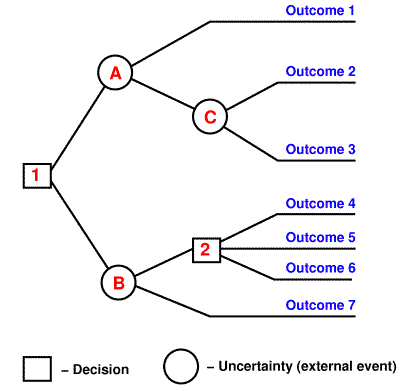|
Use a decision tree analysis to systematically arrive at your smartest choiceA decision tree is one of the most systematic tools of decision-making theory and practice. Such trees are particularly helpful in situations of complex multistage decision problems. For example, when you need to plan and organize a sequence of decisions and take into account how the choices made at earlier stages and the outcomes of possible external events determine the types of decisions and events at later stages of that sequence. A decision making tree is essentially a diagram that represents, in a specially organized way, the decisions, the main external or other events that introduce uncertainty, as well as possible outcomes of all those decisions and events. Here is a schematic example that illustrates the basic elements of decision trees.
Squares represent decisions you can make. The lines that come out of each square on its right show all the available distinct options that can be selected at that decision analysis point. Circles show various circumstances that have uncertain outcomes (For example, some types of events that may affect you on a given path). The lines that come out of each circle denote possible outcomes of that uncontrollable circumstance. Write down above each such line in the decision tree your best guesses for probabilities (for example, “80%” or “0.8”) of those different outcomes. Each path that can be followed along the decision tree, from left to right, leads to some specific outcome. You need to describe those end results in terms of your main criteria for judging the results of your decisions. Ideally, you will assign each end outcome a quantitative measure of the overall total benefit you will receive from that outcome (you can express it as a perceived monetary value). Now you have a complete decision making tree with specific numbers for both the probabilities of the uncertain events and the benefit measures (desirability) of each end result. At this stage the tree can give you more specific recommendation on what would be your best choices. In particular, for each choice that you control (at the decision points shown by squares), you can calculate the overall desirability of that choice. Just sum the benefit measures of all the end outcomes that can be traced back to that choice (via one path or another), weighted by the probabilities of the corresponding paths. This will show you the preferred choice (the one with the highest overall desirability). If you have more than one decision point, you need to do that calculation for the decisions that are at the latest stages first. Identify the choice that gives the highest overall desirability and leave only that branch (removing the decision point). Do the same with the remaining squares, working your way to the left (to the first decision point in the sequence).
Complement your decision tree analysis with the power of your intuition
Decision making skills and techniques guide
Personal time management and goal setting guide main page
Copyright 2005 by Time-Management-Guide.com. All rights reserved. |
